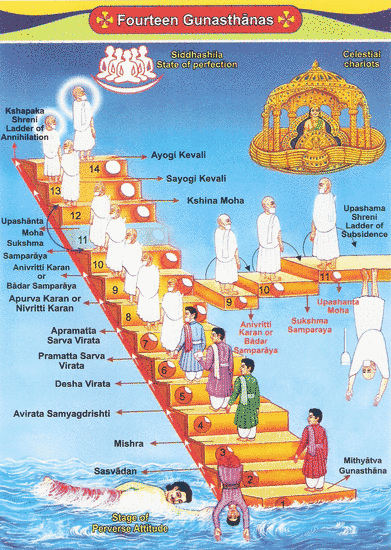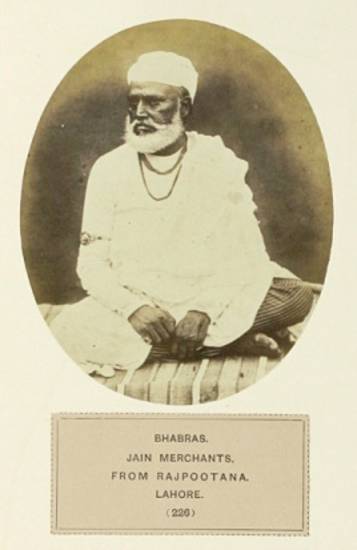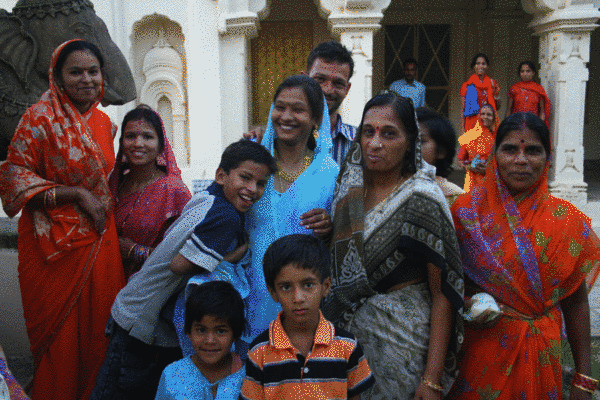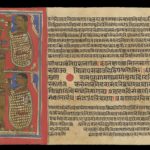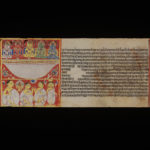Article: Scales of Perfection
The ultimate goal in Jainism – emancipation of the soul from the cycle of rebirth – is a very long and difficult road. This is surely why Jain doctrine has created a ‘Scale of Perfection’, which goes from total delusion to total omniscience. It presents the route to liberation in 14 stages. The scale has been named guṇa-sthāna, coined from Sanskrit words for the stages – sthāna – of qualities – guṇa. The scale allows lay men who are not necessarily Jain to become Jains, to reaffirm their faith in Jainism, to take the vows of monkhood and then to progress through the stages by eliminating the different forms of karma. At a certain stage, devotees are invited to leave their lay status and to become monks or nuns.
The theory of guṇa-sthāna is closely associated with the Jain doctrine of karma. This concept of karma is very complicated, with 148 main categories and numerous classes shaping the attributes of an embodied soul and influencing how karma plays out over one or more lifetimes. Aspects of these different categories are linked to the 14 stages of the guṇa-sthāna.
Approaching the sixth stage of the guṇa-sthāna, the individual can further develop spiritually only by becoming a mendicant. The step between lay and mendicant status is so great that the Jain doctrine proposes 11 more steps named pratimā to help lay people to make this important decision.
The history of the guṇa-sthāna concept is hard to trace, with only infrequent mentions in early Jain writings. The tenth-century text called the Gommaṭasāra – Essence of Mahāvīra’s Teachings – remained influential for centuries, particularly among Digambaras. In the 19th century, however, it seems that the ever-more involved theorising of the guṇa-sthāna may have helped the decline of its popularity among lay Jains. Contemporary Jains may well be unfamiliar with the complexities of the doctrine, even though the notion of spiritual progression remains a keystone of the Jain faith. In addition, scholarly work in this area is largely absent, although the great significance of the guṇa-sthāna in the path to liberation is accepted in Jain studies.
Journey to liberation
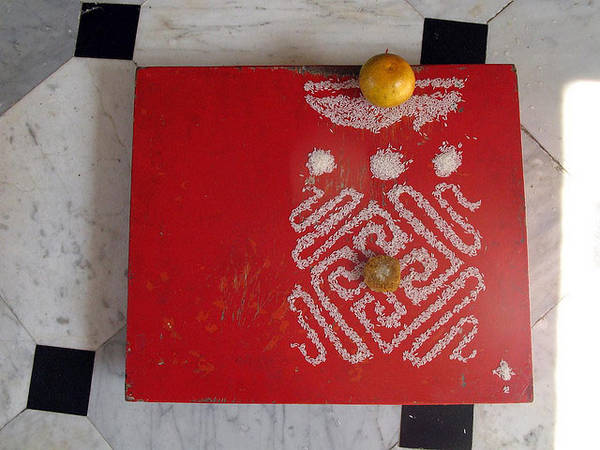
Sacred symbols in rice
Image by Cactusbones – Sue Ann Harkey © CC A-NC-SA 2.0
The fundamental aim of Jainism is the realisation of the self, the liberation of the individual soul from the cycle of births because it has no karma. To reach this state of bliss, each believer must pay attention to the ‘three jewels’ of:
Accomplishing the first jewel makes it possible to achieve the second, which allows progression to the third. The concept of the guṇa-sthāna provides a framework in which to fully accept and practise the ‘three gems‘ of Jain teachings.
Jain devotees should also concentrate their thoughts on the innate purity of the self and devote their entire lives to the attainment of this goal. It is so difficult that only monks and nuns are said to be able to achieve the state of realisation – siddhi. Formally described in the guṇa-sthāna, this process leaves aside the lay community, which is the larger part of the Jain community – sangha. However, lay Jains can advance spiritually within certain limits.
Fourteen ‘Stages of Qualities’
The 14 ‘Stages of Qualities’ – guṇa-sthāna – chart the progress of the individual soul from complete delusion to omniscience, which is necessary for mokṣa – the emancipation of the soul. The guṇa-sthāna is closely linked to the Jain theory of karma, which is extremely detailed. Jain writings discuss 148 categories of karma, which demonstrate varying qualities and durations and govern different aspects of the embodied soul. At the various rungs of the ladder of guṇa-sthānas, different karmas rise and mature and then die away. At the top of the scale, the enlightened soul still retains karmas, but these disappear in the instant after it is freed from its body.
It is considered extremely difficult to move through the stages to enlightenment. It takes many, many lives in the cycle of rebirth to move from one step to another, and karmas exist and mature over many lifetimes, with more karmas being formed in each lifetime. These may mature in the next lifetime or come to fruition much later.
Lay people can ascend only to the fifth stage. Going higher up the ladder means becoming a mendicant.
The stages are detailed in this table.
|
Stage |
Sanskrit term |
English meaning |
Detail |
|---|---|---|---|
|
1 |
mithyātva |
wrong belief |
The soul is bound by the karma of delusion – mohanīya-karman. The soul has not yet been awakened to Jain belief and so it ignores the Path of Liberation. It is heavily bound by passions and attachments. |
|
2 |
sāsvādana |
the taste of right belief |
The individual is ‘rehabilitated’ after a fall from a higher stage. The Jain has only the ‘taste’ of the ‘right belief’ – samyag-darśana – but his faith has to be reaffirmed. |
|
3 |
miśra |
mixed |
This is a transition between the wrong belief of stage 1 and the right belief in stage 4. |
|
4 |
avirata-samyag-dṛṣṭi |
right belief without self-control |
This is important because the believer is now truly a Jain and cannot go back to the wrong belief of the first stage. He has right belief – samyag-darśana – but still lacks self-control. |
|
5 |
deśa-virata |
partial self-control |
The individual has partial self-control and is now ready to take the vows of the Jain lay man – aṇu-vratas. The ‘believer’ thus becomes an ‘active member’ of the Jain community. |
|
6 |
pramatta-virata or sarva-virata |
complete self-control with carelessness |
This marks the passage from secular life to becoming a mendicant. The devotee has complete self-control, though still demonstrating some carelessness, yet is ready to take the vows of Jain mendicants – mahā-vratas. This step is very high indeed, which is why there are some degrees between the fifth and the sixth guṇa-sthāna, as detailed in the pratimā. |
|
7 |
apramatta-virata |
complete self-control without carelessness |
The mendicant now has complete self-control without carelessness, and so can observe all the vows without any faults. |
|
8 |
apūrva-karaṇa |
new process |
Having become practised in self-control, the mendicant is engaged in the new process of struggling to stop the secondary passions or emotions – no-kaṣāyas – through meditation. |
|
9 |
anivṛtti-karaṇa |
no return process |
The mendicant reaches the point where he or she cannot return to a lower stage and tries to destroy the secondary passions through meditation. |
|
10 |
sūkṣma-saṃparāya |
war against the subtle passions |
The mendicant wars against the subtle passions – kaṣāyas – through meditation. |
|
11 |
upaśānta-moha |
one whose delusion is pacified |
From this stage, the monk becomes a ‘perfect ascetic’, free from attachment, but has not yet attained omniscience. Stages 9 to 11 make a separate scale named the ‘Ladder of Pacification’ – upaśama-śreṇi – from which a fall is still possible. |
|
12 |
kṣīṇa-moha |
one whose delusion is destroyed |
The ascetic free from attachment has now destroyed delusion. He or she has not reached omniscience but the passions are completely eliminated. From here, there is no return possible to a lower level of spirituality. |
|
13 |
sayoga-kevalin |
omniscient one who still has activity in the body |
The sayoga-kevalin is an omniscient being who still has physical activity. The soul is still within the body, in order to achieve the lifespan – āyus – of the particular ascetic. |
|
14 |
ayoga-kevalin |
omniscient one without any activity |
The ayoga-kevalin is an omniscient without any activity, remaining completely still.
|
The top of the ladder leads to mokṣa, in which the soul is perfected – siddha – having become free of all karmic particles. On the death of the physical body, the soul rises up to the siddha-śilā, where it dwells for eternity experiencing its own realisation.
However, Digambaras do not believe that women can reach liberation as they hold that nudity is part of complete detachment and self-control – expressed in one of the five ‘fundamental vows’ of mendicants – and that women cannot go nude. This is because Digambara followers believe that women’s bodies contain microscopic beings that men’s do not, and which hinder the level of spiritual purity they can achieve. In addition, traditional social attitudes towards women make it impossible for them to shed their clothes as part of advanced spirituality while the scriptures stress the dangers for monks who mix with women.
Wiley states that ‘A Digambara nun (āriyikā) takes the vow of non-possession in a modified form, and she wears a white sari. Therefore, she is classified as an advanced celibate layperson in the 11th pratimā.’ (159)
Theory of karma
The elaboration of the guṇa-sthāna is closely linked with the theory of karma.
At every stage, some of the 148 categories of karma – the prakṛtis – must be unbound from the soul so it can progress to the next step. At the top of the scale, none of the karmic categories bind the pure soul and thus it can be liberated.
Classes of karma
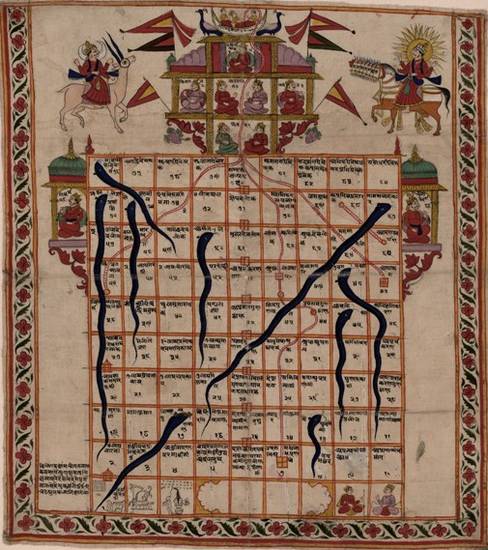
Snakes and ladders
Image by Victoria and Albert Museum © V&A Images/Victoria and Albert Museum, London
The 148 categories of karma are classified into eight main groups – the mūla-prakṛtis. These are divided into several secondary sets – the uttara-prakṛtis. Each category is defined by elements, such as duration, intensity and quantity, and presents different aspects. Among those aspects, three are particularly important for the guṇa-sthānas:
Karma and the guṇa-sthānas
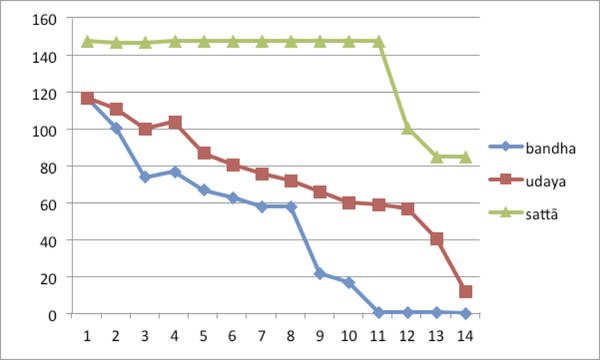
Three stages of karma during the 14 guṇa-sthānas
Image by Jérôme Petit © Jérôme Petit
At every stage of the guṇa-sthāna, certain categories of karma do not bind the soul any longer and others do not come to maturity or fruition any more. The existence of all the categories of karma is attested all along the scale. Some categories disappear in the 12th guṇa-sthāna.
The 11th stage is an important step as only one category of karma can bind the soul – the sāta-vedanīya-karman, which causes the feeling of what has been obtained. However, 59 categories of karma can still come to maturity. At the 14th and final stage, none of the categories bind the soul, but 12 categories come to maturity and 85 categories are still in existence.
Based on information given in Glasenapp 1915, this table presents details of the categories of karma – the prakṛtis – involved at every stage of the guṇa-sthāna.
|
Guṇa-sthāna level |
Karmic bondage |
Karmic maturity |
Karmic existence |
|---|---|---|---|
|
1 |
117 |
117 |
148 |
|
2 |
101 |
111 |
147 |
|
3 |
74 |
100 |
147 |
|
4 |
77 |
104 |
148 |
|
5 |
67 |
87 |
148 |
|
6 |
63 |
81 |
148 |
|
7 |
58 |
76 |
148 |
|
8 |
58 |
72 |
148 |
|
9 |
22 |
66 |
148 |
|
10 |
17 |
60 |
148 |
|
11 |
1 |
59 |
148 |
|
12 |
1 |
57 |
101 |
|
13 |
1 |
41 |
85 |
|
14 |
0 |
12 |
85 |
The graph shows at a glance how progression through the scale provokes the fall of the karmic bondage.
Duration of karma
The theory of karma gives also an idea of the time taken by the karma to fall or mature. This is the duration – sthiti – calculated with a minimum and a maximum.
The minimum a karmic category binds the pure soul is one muhūrta – approximately 48 minutes. The maximum can total 70 koṭakoṭi sāgaropama – 7 x 10225 years. If the maximum is followed, it could be a very long path through the scale of perfection!
Eleven ‘Steps of Perfection’
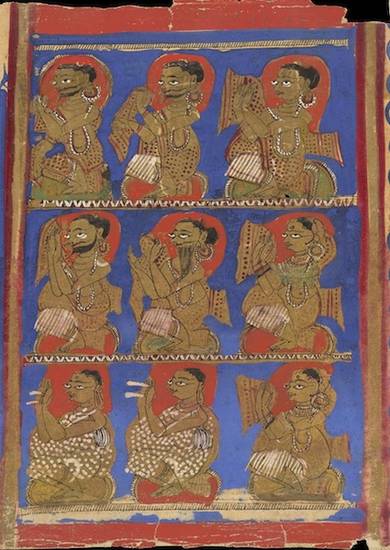
Fourfold community
Image by Wellcome Trust Library © Wellcome Library, London
Progressing from the lay part of the Jain community to the mendicant element is understood to be very difficult. To help the lay person move from the fifth guṇa-sthāna up to the sixth, the Jain doctrine proposes 11 more steps – the pratimās.
The Sanskrit term pratimā means ‘image’ or ‘statue’. In particular, it refers to the Jinas represented in art in the kāyotsarga posture. This involves standing as immobile as a statue, with arms held loosely alongside the body, which is seen as a model to follow because it is associated with very deep meditation.
The 11 steps are meant to allow lay people who wish to progress spiritually to live increasingly similarly to the mendicant lifestyle. The pratimās involve meditation and gradually renouncing activities and habits to improve self-control and improve detachment.
The table gives details of the 11 pratimās.
|
Stage |
Sanskrit term |
English meaning |
Detail |
|---|---|---|---|
|
1 |
step of belief |
The lay person simply has a firm faith in the Jain teaching. |
|
|
2 |
step of taking the vows |
The believer becomes a full ‘member’ of the Jain community by taking the fundamental vows of all Jains, namely to:
|
|
|
3 |
step of equanimity |
The lay person practises meditation in the posture of kāyotsarga and tries to consider everything with the same eye, giving the same weight to all points of view. |
|
|
4 |
The devotee fasts on certain days, training to face the difficulties of fasting. |
||
|
5 |
sacitta-tyāga |
step of renouncing food containing living beings |
The lay person pays attention to the habits of daily life by rejecting food containing living beings. Examples include roots and tubers, such as potatoes, onions and aubergines. |
|
6 |
rātribhakta |
step of renouncing sexual enjoyment |
The lay person renounces sexual enjoyment during the daytime, which is a first step before complete celibacy. It is sometimes read as rātri-bhukta-tyāga – the ‘renunciation of eating at night’ – which prevents accidentally harming living beings. |
|
7 |
brahmacarya |
step of complete celibacy |
The devotee accomplishes total celibacy. |
|
8 |
ārambha-tyāga |
step of renouncing daily activities |
This step marks a real transition from the ‘householder life’ to that of a mendicant, in that the devotee does not take an active role in the normal duties of the household and business. |
|
9 |
parigraha-tyāga |
step of renouncing possessions |
This step sees the lay person definitively leave the life of a householder by renouncing all possessions. |
|
10 |
anumati-tyāga |
step of renouncing permitted activities |
The devotee only eats what other people give him and does not cook his own food, which is permitted before this stage. Even advisory roles in standard household and business life are given up. |
|
11 |
uddiṣṭa-tyāga |
step of renouncing prescribed food |
This point marks the lay person’s final stage towards initiation as a mendicant. He or she is now ready to attain the sixth guṇa-sthāna and to take the vows of monk or nun.
|
The Digambara belief that souls cannot be emancipated while embodied within women means that women are technically not permitted to become nuns among the sect. The highest pratimā level a Digambara woman can reach is the 11th stage, according to Wiley (2004). Therefore she remains a lay woman, although she lives as a mendicant and takes the vows of a mendicant, albeit with a slightly modified vow of non-attachment.
History and reception
It is quite difficult to trace the history of these two scales of perfection in Jainism. Literary references are sparse until the first list of the guṇa-sthānas appears in the Digambara text called Ṣaṭkhaṇḍāgama – Treatise in Six Parts, composed around the third century CE. The Tattvārtha-sūtra, the only scripture accepted as authoritative by both main sects of Digambara and Śvetāmbara, also mentions the guṇa-sthānas.
The most influential text to discuss the guṇa-sthāna is Nemicandra’s two-volume work, the Gommaṭasāra – Essence of Mahāvīra’s Teachings. Written in the tenth century, it remained persuasive for centuries, especially among Digambaras. Writings on the scales of perfection became more technically involved during the 19th century, which may have helped reduce their readership among lay Jains.
Although nowadays Jains retain the idea of spiritual progression, the formal, highly technical theories of the scales of perfection are far less widespread than in previous centuries. Scholarly interest in the concept also seems to be quite unpopular, with the work of Von Glasenapp in the early 20th century followed some eighty years later by more modern research. Despite this lack of substantial academic investigation, scholars of Jain studies generally recognise the importance of the guṇa-sthānas in the journey towards liberation.
Early references
The Uvāsaga-dasāo – Ten Lay Men – is the seventh Aṅga of the Śvetāmbara canon and describes right conduct for lay Jain society. It does not evoke the guṇa-sthānas but mentions the pratimās. This text invites the devotee to reaffirm his faith in the Jain doctrine and encourages him to focus on his inner religious life. Thus the ‘Story of Ānanda’ shows how a lay man feels ready to progress through the stages of being an upāsaka, becoming the steady ‘ideal lay man’ who is the central figure of the text.
Then that Āṇanda, the servant of the Samaṇa, engaged in conforming himself to the standards of an uvāsaga. Perfectly, in thought, word and deed, he practised, maintained, satisfied, accomplished, proclaimed and completed the observance of the first standard of an uvāsaga according to the sacred writings, according to the rules prescribed in them, according to the right way, and according to the truth.
Then that Āṇanda, the servant of the Samaṇa, completed the observance of the second standard of an uvāsaga, and likewise that of the third, fourth, fifth, sixth, seventh, eighth, ninth, tenth, and eleventh standards.
Verses 70 to 71
translation by Hoernle, page 46, 1885
On the Digambara side, Kundakunda refers to the scales of perfection, mentioning both guṇa-sthānas and pratimās, but he never develops the theory. His own doctrine focuses on the purity of the self and follows an absolute point of view away from a conventional point of view where these scales take place.
The soul possesses neither stages of biological development (jῑva-sthāna) nor states of spiritual development (guṇa-sthāna), all these are modifications of the matter.
Samayasāra 2.17
translation by Zaveri / Kumar 2009
The one author to describe the scales is the philosopher Umāsvāti, whose authority is recognised by both Śvetāmbaras and Digambaras. In the ninth chapter of his Tattvārtha-sūtra, he evokes the guṇa-sthānas in their ancient form. Indeed, the scale begins with the fourth stage, at the very moment when the individual becomes a resolved Jain.
The first complete list is given in the Ṣaṭkhaṇḍāgama – Treatise in Six Parts. It is a voluminous treatise seen as a pro-canonical text by the Digambaras and the ultimate source of their teachings. Written around the third century CE, it provides a simple list of the 14 stages without any technical information.
The ‘Gommaṭasāra’
Inspired by the Ṣaṭkhaṇḍāgama, Nemicandra wrote in the tenth century a voluminous compendium named Gommaṭasāra – Essence of Mahāvīra’s Teachings. The work is divided into two books, with one each devoted to:
- the soul, called ‘Jīva-khaṇḍa’, which lists the 14 guṇa-sthānas under the name of ‘compositions of the soul’ – jīva-samāsa
- karma, called ‘Karma-khaṇḍa’, which goes into details of the karmic categories involved at each stage.
1) Wrong belief, 2) taste of right belief, 3) mixed, 4) right belief without self-control, 5) partial self-control, 6) complete self-control with carelessness, 7) the opposite (i.e. complete self-control without carelessness), 8) new process, 9) no return process, 10) war against the subtle passions, 11) pacification, 12) destroyed delusion, 13) Jina with still an activity, and 14) Jina without any activity must be understood as the fourteen compositions of the soul leading gradually to the realization.
‘Jīva-khaṇḍa’, verses 9 to 10
Gommaṭasāra
The Gommaṭasāra enjoyed great popularity among Digambara circles until the 18th century. The poet and merchant Banārasīdās provides a personal account of its influence in his autobiography, written in 1641. Inspired by the philosophy of Kundakunda, he believed that he could not devote his entire life to the realisation of the self or soul, because he was still attached to secular activities. Reading the Gommaṭasāra, Banārasīdās realised that one should act in harmony with one’s place in the scale of perfection. He was then appeased and could continue to feed both his family and his inner life.
In the mid-18th century, the Digambara scholar Paṇḍit Ṭoḍaramal wrote a Gommaṭasāra-pūjā. This poem praises the qualities of the Gommaṭasāra, attesting to the long popularity of the text.
Increasingly complex theory
The theory of guṇa-sthānas then reached a complexity that lay society could not grasp easily.
In the 19th century the poet Daulatrām wrote a short treatise for lay Jains, called the Chahaḍhāla – Six Chapters or Six Shields. This text never refers directly to the guṇa-sthānas but the chapters of the book are organised to form a progression from delusion to realisation that is similar to the ‘Scale of Perfection’ of the guṇa-sthānas.
Contemporary attitudes
Nowadays the notion of the 14 guṇa-sthānas seems to be more an object of study than a genuine practice among Jain lay society. The idea of a spiritual progression is certainly present but the technical aspects of the guṇa-sthānas do not seem to be very popular. At every stage of the guṇa-sthānas a certain kind of karma should ripen or fall, which is described by the treatises with great precision. A strong mathematical background is required to follow the theory, which perhaps means that most people cannot easily understand it.
Three main scholars have studied the guṇa-sthāna theory in particular. The German academic Helmuth von Glasenapp devotes to it a chapter of his thesis on the Doctrine of Karman in Jain Philosophy, which was first published in German in 1915 and translated into English in 1942. In 1996, Sagarmal Jain wrote an entire book on the guṇa-sthānas, followed in 2007 by Sādhvī Darśanakalāśrī.
P. S. Jaini and Nathmal Tatia also evoke the guṇa-sthāna theory in their studies as being a major element of the Jain path to liberation.
Reading
- Samayasāra Nāṭaka: Bhāshāṭīkā Sahita
Banārasīdās - edited by Buddhilāla Śrāvaka
Śrī Vītarāga Sat Sāhitya Prasāraka Ṭrasṭa; Bhāvanāgara, Gujarat, India; 1976
- Prākṛta evaṃ saṃskṛta sāhitya meṃ Guṇa-sthāna kī avadhāraṇā
Sādhvī Darśanakalāśrī - Rājarājandra Prakāśana Ṭraṣṭa; Rājagaḍha, India; 2007
- Chahaḍhālā ṭīkā sahita
Daulatrām - Māṇekacand Dośī, Maganalāl Jain and Paṇḍit Ṭoḍarmal Smārak Ṭrasṭ; Sampādak and Jaipur, Rajasthan, India; 2007
- Pt. Daulatram’s Chhahadhala
Daulatrām - translated by S. C. Jain
edited by Kusum Jain
Keladevi Sumatiprasad Trust; Delhi, India; 1993
- Guṇasthāna siddhānta: eka viśleṣaṇa
Sagarmal Jain - volume 87
Pārśvanātha Vidyāpīṭha; Vārāṇasī, Uttar Pradesh, India; 1996
- The Jaina Path of Purification
Padmanabh S. Jaini - University of California Press; Berkeley, California USA; 1979
- Samayasāra of Śrī Kundakunda
Kundakunda - translated by Appaswami Chakravarti
edited by A. N. Upadhye
Bhāratīya Jñānapītha Mūrtidevī Jaina granthamālā: English series; volume 1
Bhāratīya Jñānapīṭha; Banaras, Uttar Pradesh, India; 1971
- Samayasāra
Kundakunda - translated and edited by Jethalal S. Zaveri and Muni Mahendrakumar
Jain Vishva Bharati University; Ladnun, Rajasthan, India; 2009
- Gommaṭasāra: Śrīmat Keśavaṇṇa viracita Karṇāṭaka-vṛtti, Saṃskṛta-ṭīkā Jīvatattva-pradīpikā, Hindī anuvāda, tathā prastāvanā sahita
Nemicandra - edited by Ā. N. Upādhye and K. C. Jain
Jñānapīṭha Mūrtidevī Jaina granthamālā: Prākr̥ta granthāṅka series; volume 14, 15, 16, 17
Bhāratīya Jñānapīṭha; New Delhi, India; 1978
- Gommaṭsāra: Karma-kāṇḍa
Nemicandra Siddhantacakravartin - translated by J. L. Jaini, assisted by Brahmachari Sital Prasada
Sacred Books of the Jainas series; volume 6 and 10
Central Jaina Pub. House; Lucknow, Uttar Pradesh, India; 1927 and 1937
- ‘Banārasīdās Climbing the Jaina Scales of Perfection’
Jérôme Petit - Tracing Ancient India Through Texts and Traditions: Contributions to Current Research in Indology
edited by Robert Leach and others
Puṣpikā series; volume 4
Oxbow Books; Oxford, UK; forthcoming
- That Which Is: Tattvārtha Sūtra
Umāsvāti / Umāsvāmi - translated by Nathmal Tatia
Sacred Literature series
International Sacred Literature Trust in association with Harper Collins; London, UK; 1994
- Ṣaṭkhaṇḍāgama with Vīrasena’s Dhavalāṭīkā
Puṣpadanta and Bhūtabali - translated and edited by Hiralal Jain et alia
Jaina Sāhityoddhāraka Fund; Amaravati, Andhra Pradesh, India; 1939–1959
- Historical Dictionary of Jainism
Kristi L. Wiley - Historical Dictionaries of Religions, Philosophies, and Movements series; series editor Jon Woronoff; volume 53
Scarecrow Press; Maryland, USA; 2004
Links
- Fourteen guṇa-sthāna
-
Slideshare provides Arun Zaveri's presentation on the 14 guṇa-sthānas, first delivered in Massachusetts, USA in September 2013 as part of a lecture series during the festival of Paryuṣaṇ and Daśa-lakṣaṇa-parvan.
http://www.slideshare.net/ScientificMeditation/6-fourteen-gunasthana
- +
- aAbhavya
- aAbhinandana
- aAbhiṣeka
- aĀcāra
- aĀcārāṅga-sūtra
- aĀcārya
- aAchalbhrata
- aAḍhāī-dvīpa
- aAdharma
- aAdho-loka
- aAdhyayana
- aAdvaita Vedānta
- aĀgama
- aAghātīya
- aAghātīya-karman
- aAgnibhuti
- aAgra
- aĀhāra
- aAhiṃsā
- aAhimsa Day
- aAjita
- aAjīva
- aAkampit
- aĀkāśa
- aAkbar the Great
- aAkṣaya-tṛtīyā
- aAlauddin Khalji
- aAlbert Einstein
- aAllah
- aAlms
- aĀlocanā
- aAloka-ākāśa
- aAmāri
- aAmbikā or Kūṣmāṇḍinī
- aAnagāra
- aAnanta
- aAnarthadaṇḍa
- aAnaśana
- aAnekānta-vāda
- aAṅga
- aAniconism
- aAnojjā
- aAntarāla
- aAntarāya-karma
- aAṇu
- aAṇu-vrata
- aAnukampā
- aAnuprekṣā
- aAnusvāra
- aApabhraṃśa
- aAparigraha
- aAra
- aĀrambha
- aĀrambhaja
- aĀratī
- aArdhamāgadhī Prākrit
- aArhaṃ
- aArhat
- aArśana-āvaraṇīya-karma
- aĀrta-dhyāna
- aĀryikā
- aĀryikā Jñānamati
- aĀśātanā
- aĀścarya
- aAscetic
- aAsceticism
- aAshram
- aAspiration
- aĀsrava
- aAṣṭa-maṅgala
- aAṣṭāpada
- aAstikāya
- aAstrolabe
- aAsura
- aAtheism
- aAticāra
- aAtiśayakṣetra
- aAtithisaṃvibhāgavrata
- aĀtma-vāda
- aĀtman
- aAuṃ
- aAurangzeb
- aAuspicious
- aAusterity
- aAvadhāna
- aAvadhi-jñāna
- aĀvaraṇī-yakarman
- aAvasarpiṇī
- aAvatāra
- aAvidyā
- aAxiom
- aĀyāga-paṭa
- aĀyambil
- aĀyu-karma
- aĀyurveda
- bBabur
- bBāhubali
- bBaladeva
- bBālāvabodha
- bBandha
- bBasadi
- bBazaar
- bBhadrankarvijay
- bBhagavant
- bBhaktāmara-stotra
- bBhakti
- bBhale
- bBharata
- bBhāṣā
- bBhāṣya
- bBhaṭṭāraka
- bBhāva
- bBhāva-pūjā
- bBhāvanā
- bBhavana-vāsin
- bBhavya
- bBhavyatva
- bBhaya
- bBhoga-bhūmi
- bBhogopabhoga
- bBodhi
- bBollywood
- bBrahmā
- bBrahma-deva
- bBrahmacārī
- bBrāhmaṇa
- bBraj Bhāṣā
- bBright fortnight
- bBritish Raj
- bBuddha
- bBuddhi-sagar
- bBuddhism
- bBuddhist
- cCaitya
- cCaityavāsin
- cCakravartin
- cCakreśvarī
- cCāmara
- cCandanā
- cCandragupta
- cCandraprabha
- cCanon
- cCāritra
- cCāritramohanīya-karman
- cCarũrī
- cCaste
- cCaturvidha-saṅgha
- cCaturviṃśati-stava
- cCāturyāma
- cCE
- cCelibacy
- cCha
- cChadmastha
- cChastity
- cCheda-sūtra
- cChristian
- cChristianity
- cClergy
- cCloning
- cColophon
- cCommentary
- cConch
- cConfession
- cCongregation
- cConsecration
- cCosmology
- cCremation
- cCrore
- cCult
- cCūrṇi
- dDādā-guru
- dDalit
- dDāna
- dDaṇḍa
- dDark fortnight
- dDarśana
- dDarśanamohanī-yakarman
- dDaśa-lakṣaṇa-parvan
- dDeity
- dDelhi Sultanate
- dDerāsar
- dDeśāvakāśika-vrata
- dDetachment
- dDevanāgarī
- dDevānandā
- dDevarddhi-gani
- dDevotee
- dDhamal
- dDhanuṣ
- dDhāra
- dDharma
- dDharma-dhyāna
- dDharma-sāgara
- dDharmastikaya
- dDhātakīkhaṇḍa
- dDholak
- dDhyāna
- dDiaspora
- dDig-vrata
- dDigambara
- dDīkṣā
- dDisciple
- dDīvālī
- dDivya-dhvani
- dDNA
- dDoctrine
- dDogma
- dDonor
- dDoṣa
- dDravya
- dDravya-pūjā
- dDrone
- dDuṣamā
- dDuṣamā-duṣamā
- dDuṣamā-suṣamā
- dDveṣa
- dDvīpa
- eEast India Company
- eEightfold Path
- eEkānta-vāda
- eEkendriya
- eElder
- eElders
- eEschatology
- eEtc up to
- fFarmān
- fFast
- fFatehpur Sikri
- fFestival
- fFestschrift
- fFiruz Shah
- fFly-Whisks
- fFolio
- fFour Noble Truths
- gGaccha
- gGaṇa
- gGaṇadhara
- gGanadharavada
- gGaṇeśa
- gGaṇin
- gGarba
- gGarbha
- gGarbha-gṛha
- gGaruḍa
- gGati
- gGene
- gGenomics
- gGhātī-yakarman
- gGhātīya
- gGhaznavid
- gGhiyasuddin Tughlaq
- gGhurid
- gGloss
- gGotra-karma
- gGujarāt
- gGujarati
- gGuṇa
- gGuṇa-sthāna
- gGuṇa-vrata
- gGupti
- gGuru
- gGuruṇī
- hHagiography
- hHajj
- hHaṃsa
- hHaribhadra
- hHariṇaigameṣin
- hHasta
- hHeresy
- hHiṃsā
- hHindi
- hHindu
- hHinduism
- hHīravijaya
- hHoroscope
- hHrīṃ
- hHumayun
- hHymn
- iIconoclasm
- iIconography
- iIdol
- iIndian Independence
- iIndology
- iIndra
- iIndrabhūti Gautama
- iIndriya
- iInitiation
- iIntercession
- iInvocation
- iIQ
- iIslam
- iIslamicate
- iIṣṭadevatā
- iĪśvara
- jJagat
- jJahangir
- jJain
- jJaina Devanāgarī
- jJaina Śaurasenī
- jJaina-dharma
- jJainaśāsana
- jJainness
- jJaisalmer
- jJamāli
- jJambū-dvīpa
- jJames Burgess
- jJanma
- jJanma-kalyāṇa
- jJarā
- jJāti
- jJina
- jJina-āgama
- jJina-bhavana
- jJina-bimba
- jJina-mātā
- jJinacandra-sūri
- jJinadatta
- jJinaprabha
- jJīva
- jJñāna
- jJñāna-āvaraṇīya-karma
- jJñāna-āvarṇiya
- jJñānsundar
- jJyotiṣka
- kKāla
- kKālakācārya-kathā
- kKālidāsa
- kKalpa-sūtra
- kKalpa-vṛkṣa
- kKalyāṇaka
- kKalyanvijay
- kKamaṇḍalu
- kKamaṭha
- kKarma
- kKarma-bhūmi
- kKarma-grantha
- kKarma-prakṛti
- kKarma-vāda
- kKarmon
- kKarnataka
- kKaṣāya
- kKathā
- kKāvya
- kKāya
- kKāyotsarga
- kKeśa-loca
- kKetu
- kKevala-jñāna
- kKevalin
- kKhalji
- kKharatara-gaccha
- kKnowledge
- kKriyā
- kKriyā-vāda
- kKṛṣṇa
- kKṣamā-śramaṇa
- kKṣapakaśreṇi
- kKṣatriya
- kKṣullaka
- kKulakara
- kKundakunda
- kKunthu
- lLabdhi
- lLaity
- lLakh
- lLāñchana
- lLands of Action
- lLaukāntika
- lLavaṇa-samudra
- lLeśyā
- lLiṅga
- lLinguistics
- lLoka
- lLoka-ākāśa
- lLoka-puruṣa
- lLoka-vāda
- lLotus
- lLotus lake
- mMadhya-loka
- mMahā-videha
- mMahā-vrata
- mMahābhārata
- mMahāmastakābhiṣeka
- mMāhārāṣṭra
- mMāhārāṣṭrī Prākrit
- mMahattarā Yākinī
- mMahāvīr Jayantī
- mMahāvīra
- mMakāra
- mMakkhali Gośāla
- mMalli
- mMāna-stambha
- mManaḥ-paryāya-jñāna
- mMaṇḍala
- mMaṇḍapa
- mMandit
- mMaṅgala
- mMantra
- mMantras
- mManuṣya-loka
- mMarāṭhī
- mMārgaṇā
- mMartyr
- mMarudevī
- mMaṭha
- mMati-jñāna
- mMauryaputra
- mMecca
- mMendicant lineage
- mMetarya
- mMiracle
- mMithyādṛṣṭi
- mMohandas Gandhi
- mMohanīya-karma
- mMokṣa
- mMonastic order
- mMonasticism
- mMonk
- mMonotheism
- mMosque
- mMount Meru
- mMount Sammeta
- mMṛgāvatī
- mMughal
- mMuhammad
- mMuhammad bin Tughlaq
- mMuhpattī
- mMūla-sūtra
- mMūlaguṇa
- mMumbaī
- mMuni
- mMunisuvrata
- mMurad Bakhsh
- mMūrti-pūjaka
- mMuslim
- mMysticism
- nNābhi
- nNāga-kal
- nNāgapurīya Tapā-gaccha
- nNāgarī
- nNāma-karma
- nNamaskāra-mantra
- nNami
- nNandīśvara-dvīpa
- nNandivardhana
- nNandyāvarta
- nNāraka
- nNāraki
- nNasalisation
- nNātha
- nNavrātrī
- nNaya-vāda
- nNemi
- nNidāna
- nniggaṃthāṇa vā 2
- nniggaṃtho vā 2
- nNigoda
- nNihnava
- nNikṣepa
- nNirgrantha
- nNirjarā
- nNirvāṇa
- nNiryukti
- nNiṣidhi
- nNitya
- nNiyati
- nNo-kaṣāya
- nNudity
- nNun
- oOcean of milk
- oOmniscience
- oOrdination
- ppa°
- pPadmaprabha
- pPadmāsana
- pPadmāvatī
- pPādukā
- pPalanquin
- pPalette
- pPañca-muṣṭi
- pPāṇḍava
- pPaṇḍit
- pPandit Dalsukh D. Malvania
- pPandit Sukhlalji
- pPāṇipātra
- pPāpa
- pParamātman
- pParameṣṭhin
- pPāraṇā
- pParigraha
- pPariṇāma
- pParīṣaha
- pParokṣa
- pPārśva
- pPārśvanātha
- pParyāya
- pParyuṣaṇ
- pPaṭa
- pPatan
- pPātra
- pPenance
- pPersian
- pPhala
- pPhilology
- pPicchikā
- pPilgrimage
- pPīr
- pPolymath
- pPoṣadha
- pPossession
- pPothī
- pPrabhas
- pPradakṣiṇā
- pPradeśa
- pPrākāra
- pPrakīrṇaka-sūtra
- pPrākrit
- pPramāda
- pPramukhā
- pPrati-vāsudeva
- pPratikramaṇa
- pPratimā
- pPratiṣṭhā
- pPratyākhyāna
- pPratyakṣa
- pPravacana
- pPrāyaścitta
- pPrayer
- pPre-modern
- pPreach
- pPredestination
- pProtestant
- pProvenance
- pPudgala
- pPūjā
- pPujārī
- pPukharavara-dvīpa
- pPuṇya
- pPūrva
- pPuṣkara-dvīpa
- pPuṣpadanta
- pPyre
- qQur’an
- rRāga
- rRāhu
- rRainy season
- rRajasthan
- rRajasthani
- rRājimatī
- rRajoharaṇa
- rRajput
- rRāma
- rRāmāyaṇa
- rRangoli
- rRās-garbā
- rRasa
- rRathanemi
- rRatna-traya
- rRātri-bhojana
- rRaudra-dhyāna
- rRecto
- rRelic
- rRenunciation
- rRetroflex
- rRevatī
- %Ṛg-veda
- rRite
- rRosary
- %Ṛṣabha
- %Ṛṣabhanātha
- rRupee
- sSaciyā Mātā
- sSādhu
- sSādhvī
- sSāgāra
- sSaint
- sŚaivaism
- sŚaka-saṃvat
- sSallekhanā
- sŚalya
- sSamacatuṣṭha
- sSamādhimaraṇa
- sSamaṇi
- sSāmarambha
- sSamavasaraṇa
- sSāmāyika
- sSaṃbhava
- sSamiti
- sSaṃjñā
- sSaṃkalpaja
- sSaṃsāra
- sSamudghāta
- sSaṃvara
- sSaṃvega
- sSamyak-cāritra
- sSamyak-darśana
- sSamyak-jñāna
- sSamyaktva
- sSaṃyama
- sSanctuary
- sSandalwood
- sSaṇgha
- sSanskrit
- sSant
- sŚānti
- sSapta-bhaṅgi-naya
- sSārambha
- sSarasvatī
- sSarvajña
- sSāsan-devi
- sŚāsana-devatā
- sŚāstra
- %Ṣaṭ-jīvanikāya
- sSatī
- sSatīmātā
- sSatya
- sSchism
- sScribe
- sScripture
- sSect
- sSecularism
- sŚenāī
- sSermon
- sŚeṣavatī
- sSevā
- sSeven fields of donation
- sShah Jahan
- sShantidas Jhaveri
- sShrine
- sSiddha
- sSiddha-śilā
- sSiddhacakra or Navadevatā
- sSiddhānta
- sSiddhārtha
- sSiddhi
- sSikh
- sSikhism
- sŚikṣā-vrata
- sŚīla
- sSin
- sSindh
- sŚītala
- sŚiva
- sSkandha
- sSomanatha
- sŚraddhā
- sŚramaṇa
- sŚrāvaka
- sŚrāvakācāra
- sŚrāvikā
- sŚreyāṃsa
- sŚrī
- sŚrīvatsa
- sŚruta-jñāna
- sŚruta-pañcamī
- sSthānaka-vāsin
- sSthāpanācārya
- sSthāvara
- sSthavira
- sSthiti
- sStrīmukti
- sStūpa
- sSubcontinent
- sSudarshana
- sŚuddhi
- sSudharma
- sŚūdra
- sSufism
- sSukha
- sŚukla-dhyāna
- sSulasā
- sSultan
- sSumati
- sSundarśrī
- sSupārśva
- sSūri
- sSuṣamā
- sSuṣamā-duṣamā
- sSuṣamā-suṣamā
- sSūtra
- sSuyam me ausam! Tenam bhagavaya evamakkhayam
- sSvādhyāya
- sSvāhā
- sSvastika
- sŚvetāmbara
- sŚvetāmbara Terāpanthin
- sŚvetāmbaras
- sSwan
- sSyād-vāda
- tTabla
- tTantra
- tTapā-gaccha
- tTapas
- tTāraṇ Svāmī Panth
- tTattva
- tTattvārtha-sūtra
- tTemple
- tTemple-city
- tThe Enlightenment
- tTheology
- tThree worlds
- %Ṭīkā
- tTilaka
- tTīrtha
- tTīrthaṃkaranāma-karman
- tTīrthankara
- tTransliteration
- tTrasa
- tTrasa-nāḍī
- tTriśalā
- tTriṣaṣṭi-śalākā-puruṣa-caritra
- tTti bemi
- tTughlaq
- tTunk
- uUdumbara
- uUniversal History
- uUpādhyāya
- uUpāṅga
- uUpaniṣads
- uUpāsaka
- uUpasarga
- uUpāśraya
- uŪrdhva-loka
- uUtsarpiṇī
- uUttarādhyayana-sūtra
- vVāhana
- vVaimānika
- vVairāgya
- vVaiṣṇava
- vVaiśramaṇa
- vVaiśya
- vValabhī
- vVanaspatikāya
- vVandana
- vVaṇik
- vVarṇa
- vVāsudeva
- vVāsupūjya
- vVayubhūti
- vVeda
- vVedanīya-karma
- vVegetarianism
- vVehicle
- vVernacular
- vVerso
- vVidyā
- vVidyā-devī
- vVihāra
- vVijñapti-patra
- vVikrama-saṃvat
- vVikṛti
- vVimala
- vVinaya
- vVipāka
- vVirji Vora
- vVirodhaja
- vVīrya
- vVisarga
- vViṣṇu
- vVītarāga
- vVizier
- vVotive
- vVow
- vVrata
- vVS
- vVyakta
- vVyantara
- vVyasana
- yYakṣa
- yYakṣī
- yYantra
- yYaśoda
- yYaśovijaya
- yYati
- yYātrā
- yYoga
- yYoginī
- yYojana


